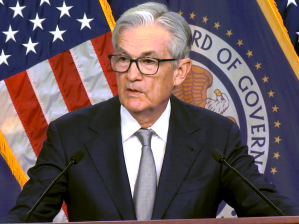Interest Rates Hold Steady for Now
Much progress has been made toward reducing inflation, but don't rule out another rate hike in the near future.

Federal Reserve Chair Jerome Powell speaks at a press conference following the announcement. Screenshot by Gabriel Frank
At its penultimate meeting of the year, the U.S. Federal Reserve Open Markets Committee announced on Wednesday that it will keep interest rates where they are, currently at a range of 5.25 to 5.5 percent. The rates now sit at their highest level in 22 years, as the central bank seeks to balance its commitment to reducing inflation as far as possible while preserving Americans’ purchasing power.
At a press briefing, Federal Reserve chair Jerome Powell noted that the decision was motivated by rising GDP, consistently strong job growth and “nominal” wage increases. “Recent indicators suggest that economic activity has been expanding at a strong, pace, well above expectations,” Powell said.
Yet Powell did not rule out another rate hike in the near future, possibly as soon as the next FOMC meeting. “A few months of good data are only the beginning of what it will take to instill confidence that inflation will go down sustainably toward our goal,” Powell said.
A delicate balance
Predictions in the runup to Wednesday’s announcement were widely shared within the commercial real estate industry, given the recently strong data surrounding the unchanged consumer price index and labor market, alongside incremental increases in treasury rates of all durations.
Ryan Severino, chief economist & head of U.S. research at BentallGreenOak predicted the pause and believes that it will be the right approach for the foreseeable future. “The economy continues to expand while inflation is slowing,” Severino told Commercial Property Executive before the announcement. “A lot of the unusual circumstances that caused high inflation continue to abate, and there is not a prescriptive timeline to return inflation to target.”
To some, a rate hike any time soon could disrupt this balance. “I don’t believe that (the Fed) will want to run the risk of overtightening, and (will) instead prefer to take a wait-and-see approach as they continue to assess the totality of the incoming data,” predicted Nick Villa, an economist at Moody’s Analytics CRE.
For Villa, patience is a necessity given the time that some indicators, such as owners’ equivalent rent flow, affect shelter inflation, which accounts for nearly a third measurement of the CPI. “This is something that takes time to work through the system and raising interest rates by another 25 basis points would do little to expedite this process,” he said.
READ ALSO: Investor Appetite for Retail Returns, But…
Similar to reactions to many recent Fed meetings, industry experts do not anticipate any changes to lending terms, with Villa seeing established, “relationship-driven” lending as the most important feature of underwriting. “Looking ahead to 2024, I believe that we’re more likely to see bid-ask spreads narrow, rather than widen,” he said.
Ultimately the key driver of more favorable lending terms, and in turn, higher transaction volumes across sectors, will be more confidence in the long-term stability of the rates. Investors and lenders share this view. Keyvan Ghaytanchi, chief investment officer at BEB Capital, has observed this trend directly. “It’s not so much about a raise, but what they will do with the market going forward,” he told CPE in an interview. “Investors do not like uncertainty,” he added.
Others welcomed the announcement, perceiving the current funds rate to be at the peak and encouraging investors to pursue new deals. “It is welcome news that the cost of debt will not rise this month,” remarked Harry Klaff, principal & U.S. president of Avison Young. “The market will be seeking certainty going into the fourth quarter on whether we are now at the peak for interest rates, as that would encourage opportunist investors to take advantage of lower prices and start buying again,” Klaff said.
Will rates stay higher for longer?
When the Fed will begin cutting rates is anyone’s guess, but a key marker of its decision will be a natural, further slowing of the economy, according to Severino. But when is this likely to take place? “I can’t imagine the Fed cutting before mid-2024,” Severino told CPE. However, this prediction remains contingent on “meaningful signs of slowing.”
Villa tentatively shares this assessment but noted the uncertainty about what may emerge before the Fed’s next opportunity to modify its policy. The biggest concerns are inflation ticking up once more, as well as complications arising from domestic and international political crises. “There is a lot of uncertainty between now and then, especially when you consider the heightened geopolitical tensions of late, and even domestic political risk in the sense that it took over three weeks to nominate a new speaker of the House,” Villa noted.
After all, markets had priced in rate cuts in the range of up to 50 basis points at the start of the year. “That never happened, and I would not be surprised if inflation turns out to be stickier than expected, and we once again see rate cut expectations pushed out even further,” Villa told CPE. With the potential for such developments as persistent inflation, an escalation of the Israel-Hamas war and a potential government shutdown in November, there is too much in play to predict when the Fed will moderate.
“I always remind everyone that there are really good reasons why the Interest Rate Forecasters’ Hall of Fame is still completely vacant,” Severino observed.







You must be logged in to post a comment.